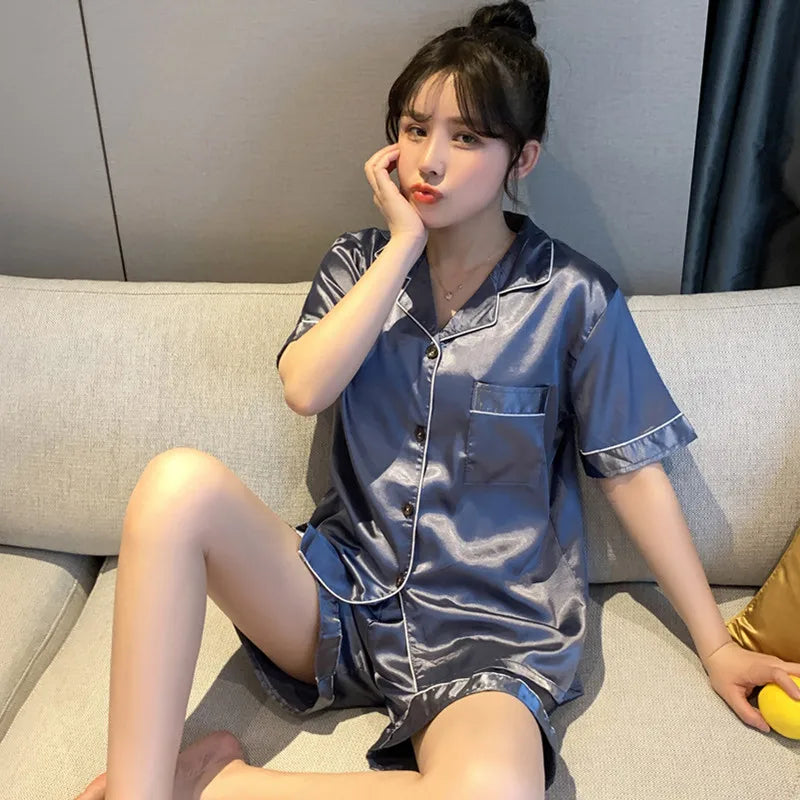What Language is Pajama? Exploring the Global Journey of a Comfort Classic
Table of Contents
- Introduction
- The Etymology of Pajamas
- Pajamas Across Different Languages
- The Historical Journey of Pajamas
- The Modern Pajama: Styles and Trends
- Cultural Perspectives on Pajamas
- The Future of Pajamas
- Conclusion
- FAQ
Introduction
Did you know that the word "pajama" has traveled across continents and cultures, evolving in meaning and form? As we settle into our favorite nightwear, it’s easy to overlook the rich history and linguistic journey behind the garments we cherish. Pajamas are more than just soft garments that cradle us to sleep; they are a reflection of cultural exchanges and historical shifts that span centuries.
At Relaxed Nights, we believe in celebrating not only the beauty of our premium night dresses but also the stories that accompany them. Our journey began with a vision to elevate how women experience their evenings, nights, and mornings, rooted in the belief that every woman deserves to feel comfortable and beautiful. In this blog post, we will explore the origins of the word "pajama," the languages that have contributed to its evolution, and how these garments have become a staple in modern wardrobes around the globe.
By the end of this post, you will not only understand what language is "pajama" but also appreciate the cultural significance embedded in these cozy outfits. We’ll delve into the etymology of the word, its variations across languages, and how pajamas have transformed from traditional attire to contemporary fashion.
Join us as we embark on this fascinating journey, uncovering the layers of history and culture woven into the fabric of pajamas.
The Etymology of Pajamas
The term "pajama" comes from the Urdu word "pāy-jāma," which translates to "leg garment." This term itself is derived from the Persian "pāy-jāma," where "pāy" means "foot" or "leg," and "jāma" means "garment." The adoption of this word into the English language reflects a significant cultural exchange during the British colonial era in the 18th and 19th centuries, when British colonists encountered this comfortable attire in the Indian subcontinent.
Originally, pajamas were loose-fitting trousers worn by both men and women in various countries across South Asia and the Middle East. They served as an everyday garment, often paired with tunics and robes. With the rise of British influence in India, pajamas began to be adopted as loungewear and nightwear in the West, particularly during the Victorian era.
It wasn’t until the mid-19th century that pajamas became popularized in Europe and North America as formal nightwear for men, a trend that gradually extended to women as well. The transformation of pajamas into a fashionable item is a reflection of changing attitudes towards comfort and elegance in sleepwear, which we at Relaxed Nights are proud to embody in our collections.
Key Points:
- The word "pajama" originates from Urdu and Persian, meaning "leg garment."
- Pajamas have their roots in South Asian and Middle Eastern attire.
- British colonial influence played a crucial role in introducing pajamas to the Western world.
Pajamas Across Different Languages
As we explore what language is "pajama," it's fascinating to note how this term has been adopted and adapted in various languages around the world. Here's a look at how different cultures refer to this beloved garment:
- English: Pajamas (American English) or Pyjamas (Commonwealth English)
- Spanish: Pijama
- French: Pyjama
- German: Pyjama
- Italian: Pigiama
- Hindi/Urdu: पाजामा (pājāmā) / پاجامہ (pājāma)
- Mandarin Chinese: 睡衣 (shuìyī), which means "sleeping clothes"
- Japanese: パジャマ (pajama)
Each of these terms carries its own cultural connotations and styles, reflecting how pajamas are woven into the fabric of daily life across different societies. For instance, in many Asian cultures, pajamas are often loose and breathable, designed for comfort in warm climates. In contrast, Western styles have evolved into more tailored and varied designs, which can include everything from flannel to silk.
At Relaxed Nights, we pride ourselves on offering a variety of nightwear that respects these cultural inspirations while providing the utmost comfort and elegance.
Key Points:
- The term "pajama" has been translated into various languages, reflecting cultural adaptations.
- Different regions have unique styles and materials associated with pajamas.
- Understanding these variations enriches our appreciation for this universal garment.
The Historical Journey of Pajamas
The evolution of pajamas is not just a linguistic journey; it’s also a historical one. Pajamas were first introduced to the Western world in the 17th century, primarily as “lounging attire” for men. However, they quickly fell out of favor until they made a comeback in the Victorian era, around 1870, when they were embraced as fashionable nightwear.
During this time, pajamas were often associated with the upper class and were made from luxurious materials such as silk and satin. The introduction of pajamas into women’s fashion marked a significant turning point, as women began to seek comfort without sacrificing elegance. This shift is mirrored in our own collections at Relaxed Nights, where we meticulously craft night dresses that offer both style and comfort for the modern woman.
As we moved into the 20th century, pajamas continued to evolve. The liberation movements of the 1920s and 1930s saw women embracing more practical and comfortable clothing, including pajamas. Icons like Coco Chanel popularized the pajama look, making it a symbol of elegance and empowerment.
In the decades that followed, pajamas oscillated between formal and casual wear, reflecting broader societal changes. Today, pajamas are worn not only for sleeping but also as fashionable loungewear, highlighting their versatility and enduring appeal.
Key Points:
- Pajamas transitioned from a 17th-century men’s fashion to a staple in women’s nightwear.
- The Victorian era marked the popularization of pajamas as fashionable attire.
- The 20th century saw pajamas embraced as symbols of comfort and empowerment.
The Modern Pajama: Styles and Trends
In today’s fashion landscape, pajamas have undergone a remarkable transformation, evolving into a diverse array of styles that cater to various preferences. Let’s explore some of the most popular types of pajamas and how they reflect contemporary trends.
1. Traditional Pajamas
Traditional pajamas typically consist of a two-piece set with a button-up shirt and matching pants. They are often made from soft fabrics like cotton or flannel, making them ideal for a cozy night's sleep. This classic style remains a favorite and is available in a variety of patterns and colors.
2. Nightgowns
Nightgowns are a popular alternative to traditional pajamas, offering a more feminine silhouette. Made from lightweight materials such as silk or satin, nightgowns provide breathability and elegance, making them perfect for warm nights. Our collection features exquisite nightgowns that embody grace and comfort.
3. Onesies
Onesies have gained immense popularity in recent years, appealing to both children and adults. These all-in-one garments are not only cute but also incredibly comfortable, making them a favorite for lounging and sleepovers. We at Relaxed Nights offer stylish onesies that ensure you stay cozy while looking chic.
4. Loungewear Sets
With the rise of remote work and a more relaxed approach to home attire, loungewear sets have become a staple in many wardrobes. These sets often combine stylish tops with comfortable bottoms, allowing for easy transitions from daytime activities to evening relaxation. Our carefully curated loungewear sets reflect a commitment to quality and comfort.
5. Luxury Sleepwear
Luxury sleepwear is defined by its use of high-quality materials and sophisticated designs. Items made from silk, modal, and other fine fabrics offer a touch of indulgence. Our premium night dresses are crafted with the finest materials, ensuring you feel pampered every night.
Key Points:
- Pajamas have evolved into various styles, including traditional sets, nightgowns, onesies, loungewear, and luxury sleepwear.
- Each style caters to different preferences and occasions, reflecting contemporary fashion trends.
- Relaxed Nights offers a wide range of nightwear that combines comfort with elegance.
Cultural Perspectives on Pajamas
Pajamas hold different meanings and significance across cultures, often reflecting societal norms and values. In some cultures, pajamas are strictly associated with home life and never worn in public. In contrast, others have embraced pajamas as fashionable daywear.
Global Variations
- Western Cultures: In many Western countries, pajamas have transitioned from strictly nightwear to casual daytime attire, especially in the wake of the COVID-19 pandemic. The trend of wearing pajamas in public has gained acceptance, leading to a more relaxed attitude towards loungewear.
- Middle Eastern and South Asian Cultures: In many Middle Eastern and South Asian cultures, pajamas remain traditional garments worn at home. They are often paired with long tunics or kurtas, emphasizing modesty and comfort.
- Japanese Culture: In Japan, traditional sleepwear includes garments such as the "yukata," a lightweight cotton kimono worn during the summer months. The emphasis on comfort and simplicity aligns with the Japanese aesthetic, which values minimalism.
Key Points:
- Cultural perspectives on pajamas vary significantly, influencing how they are worn and perceived.
- In Western cultures, pajamas have become acceptable as casual daywear, while in other cultures, they remain primarily home attire.
- Pajamas reflect cultural values, traditions, and aesthetics, showcasing their global significance.
The Future of Pajamas
As we look ahead, the pajama industry continues to evolve in response to changing consumer preferences and societal trends. Comfort remains paramount, but there is also an increasing focus on sustainability and ethical production practices.
At Relaxed Nights, we are committed to providing premium nightwear that not only enhances comfort but also aligns with values of quality and sustainability. Our collections are designed to empower women to embrace their evenings and mornings with grace, knowing they are dressed in pieces that are thoughtfully crafted and ethically produced.
Key Points:
- The pajama industry is evolving towards sustainability and ethical practices.
- Comfort remains the core focus, but consumers are increasingly interested in the environmental impact of their clothing.
- Relaxed Nights is dedicated to providing premium nightwear that aligns with these values.
Conclusion
Pajamas are more than just clothing; they are a symbol of comfort, cultural exchange, and evolving fashion trends. From their etymological roots in Urdu and Persian to their contemporary styles, pajamas encapsulate a rich history that continues to evolve today.
As we explore what language is "pajama," we uncover a tapestry of cultural significance that spans the globe. At Relaxed Nights, we celebrate this journey by offering elegant and comfortable nightwear that empowers women to embrace their evenings with style.
As you reflect on your own nightly routines, consider how the comfort of quality sleepwear can transform your experience. Whether you prefer traditional pajamas, luxurious nightgowns, or cozy onesies, we encourage you to find pieces that resonate with your personal style and elevate your sense of comfort.
FAQ
What does the word "pajama" mean?
The word "pajama" comes from the Urdu "pāy-jāma," meaning "leg garment." It reflects a cultural exchange that has transformed this attire into a global staple.
What languages use the term "pajama"?
"Pajama" is used in English, while variations include "pijama" in Spanish, "pyjama" in French, and "pigiama" in Italian, among others.
How have pajamas evolved over time?
Pajamas have transformed from traditional garments worn primarily in the East to fashionable nightwear in the West, reflecting changes in societal norms and preferences.
What types of pajamas are available today?
Today, pajamas come in various styles, including traditional sets, nightgowns, onesies, loungewear, and luxury sleepwear, catering to different tastes and occasions.
Why is comfort important in sleepwear?
Comfort is essential in sleepwear as it directly impacts the quality of sleep and relaxation, allowing individuals to unwind and enjoy their evenings.
For those looking to elevate their nightly routines, we invite you to explore our curated collections at Relaxed Nights, where elegance meets comfort. Together, let’s embrace the art of relaxing in style.



